
Part 2: This begins right where the previous one left off, and tells the story of the Bannerman acquisition, and his later supreme court trial against the Winchester company for patent infringement. It also chronicles how Bannerman’s changes to the guns, how he further marketed and developed them, and then tells the fate of the company and design. It also shows some experimental rifles he tried out using the same action. By the time he stopped producing these, their previous market success and Bannerman’s business know how ended up with him producing over 6 times as many guns as the Spencer Arms Co. had been able to, and nearly all of the revisions we see today from the 2nd model Spencer made guns are because of him.
(Part 1…. HERE! )
The F. Bannerman years…
In December 1899, a liquidation of the Spencer company happened due to their recent bankruptcy, in which Pratt and Whitney and others with financial interests had put the company up for sale. This lead to an eccentric group of investors trying to buy it up, who told a surplus military goods dealer named Francis Bannerman about this as well. Bannerman ended up with the winning bid, beating Winchester and others to the rights for the company, and then started a full scale takeover. When the Spencer Arms Co went bankrupt and was liquidated fully to Bannerman, C.M. Spencer gave all assets owned by him to Bannerman.

First, I will tell you a bit about Francis Bannerman’s start in firearms….In 1872, Bannerman began buying from army auctions and soon began noticing the useful and historic war weapons being scrapped for metal by companies buying these weapons. Not long after that, he began buying these arms up and began to resell them successfully from a store front. Later he started sending out an illustrated catalog to collectors, and countries who may be looking to outfit their troops with second hand, yet modern arms at cheap prices. He also supplied everyday frontiersmen with fowling guns made from the old army stocks, which he also later altered into “Quaker guns” for boys brigades and military schools. The Assistant Chief of Ordnance stated that “Bannerman has done so much good toward training the youth of America with his Quaker drill guns, that the United States could well afford to pay him a bounty on each gun made.” He later opened stores in New York City, first at 118 Broad Street in 1887, then 27 Front Street in 1892, and finally another in 1897 at 579 Broadway, where he outfitted many regiments during the Spanish-American War. After the war, he purchased over 90 per cent of the captured war material from the United States Government, and then bought historic Pollepel Island, in the Hudson Highlands opposite Cornwall, now known to the public as Bannerman’s Island.
Bannerman was very successful and was not only the largest surplus dealer in the world by 1891, but also was the acknowledged founder of the military surplus business as we know it today. By 1895 he was the worlds foremost authority on military supplies and values of arms. His illustrated catalog of more than 400 pages, was known to collectors as the best book on the subject and one of the best places to find items that would outfit second world armies. At the request of the US Government, he made a book called a History of War Weapons that was used as reference material for years to come. He also originated the “sealed bid” plan of selling obsolete Government surplus arms and goods to individuals without bidding wars. His inventory and storage were so extensive on his island, that at the outbreak of the European War in 1914, he supplied the French Army with an order of 8,000 saddles in just 7 weeks from start to finish, all off of current stock he already had. Later that year, as a loyal Scot, he donated thousands of rifles, cartridges, artillery etc., to the British Army for their Great War effort. By 1916, his resources were so extensive that he had converted a large ocean steamer into a warship, and delivered it in just one week after buying it, and he had been selling more arms from his stock than some world renowned arsenals were.
~Bannerman repeating shotguns~
Now that we are caught up. Bannerman started moving most of the company’s production machinery to New York in January 1890, and then started formal foreclosure lawsuit actions against the failed Spencer Arms company and its officers. Later that year on May 2nd, 1890, the supreme court decided in Bannerman’s favor to kick out all officers and workers from the company, and granted him full control. This subsequently lead Spencer Arms Co. to be ordered to pay $19,328.41 immediately. As said before in the last section, this had already led Christopher Spencer to have to give up all of his rights, titles, interests, and patents to Bannerman in lieu of payment. This also nullified any royalties or payments being available for Spencer, any workers, or any officers of the company in the years that followed. Bannerman then decided to move the entire operation to Brooklyn, New York and began to set up machines to resume production of these shotguns in the fall of 1890.
The Model 1890
By December 1890, Bannerman had moved the machinery and restarted production of the shotguns by using up the last of the Spencer Model 1887 receivers, which went till at least Serial #3236 that I’ve seen personally (and likely more). When his operation ran out of these receivers, they started producing more and started roll marking them as the Bannerman Model 1890. This model was unchanged minus the markings and the various different fore ends that we see. 4 variations exist of these and include the Gutta Percha fore end from the latest of the Model 1887 Spencers. Those Gutta Percha ones would go on to be used till at least 1895 (as evident by a sales ad from that year), and another 3 forend variations were also installed at times. These include the “furniture leg” style grip, the “straight double flared end” style grip, and the “palm swell flared end” grip as i call them. About ~9000 of this new 1890 model would be made over the next 3 to 5 years till serial ~12,000 ish.
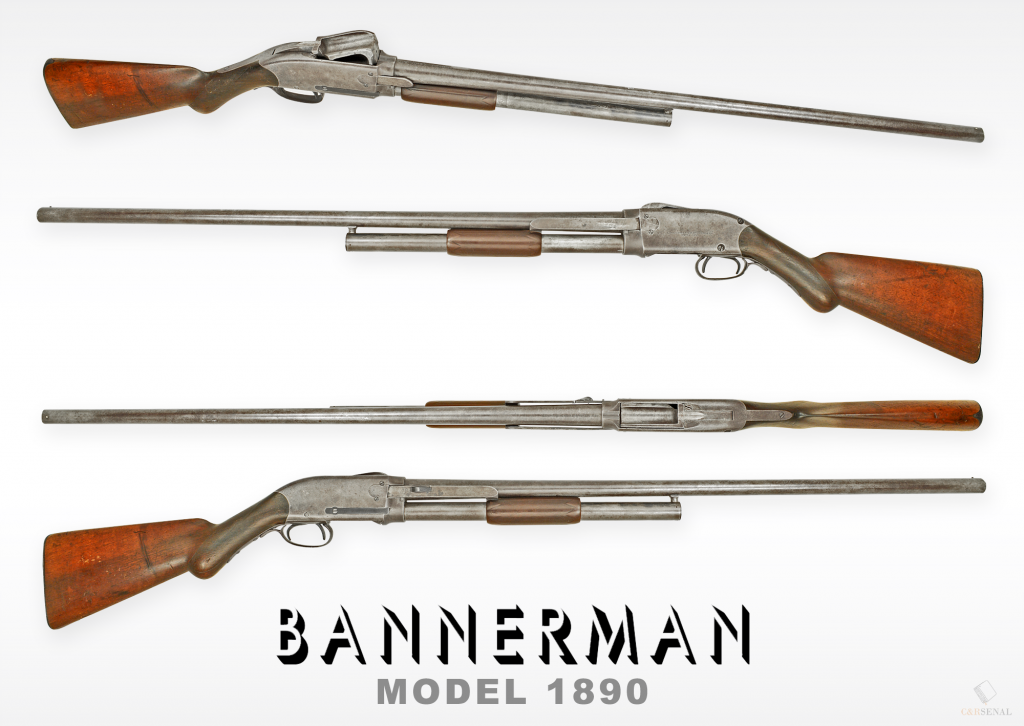




Possible Model 1894 and Bannerman rifles
Bannerman would later go on to advertise what they called an 1894 model… although, they are either very rare, or more likely never existed and were just 1890 models with a new forend on an otherwise unchanged gun…these were probably marketed in brochures as a new model to try and increase sales as was common at the time for Bannerman and others, although, they are either very rare, or were just marketed in brochures as such to try to increase sales….as most Bannerman guns were very talked up in their ads to drum up business at that time, and pictures or records of ones marked as such have been impossible to find in the past 5 years. Serial numbers on these are unknown if they even exist. This is also what Roy Marcot had theorized about this model too in his books and from what the Cody Firearms Museum had told him. I have also been thoroughly unable to find ANY guns marked as such, or anyone claiming to have even seen one marked as such.
Sometime around this period, Bannerman also experimented with pump action rifles using this same design, and produced at least one highly engraved example of these.(See pics below) These had a smaller receiver and pump, with bottom load like the shotguns, and used the same tilting breech block as the others. They also all had octagonal barrels it seems from the few examples out there currently.








The Model 1896
In late 1895, Bannerman discontinued the Gutta Percha fore ends, but kept using some of the “Palm Swell double flare” style fore ends for a little while. These guns were basically identical to the model 1890 minus new markings, a stamped sheet steel magazine tube with trapezoidal teeth holding it together that holds the follower in a bit differently, and yet another new forend design. These guns were now marked as the “Bannerman Model 1896” and the forend was changed to the “Corn cob” fore end, or “6 groove style” that would be the standard continued for the entire rest of the guns production. Bannerman made around ~6000 of this model from late 1895 till about 1898 at serial #18,000-ish. Latest serial i have seen on one was #17,965
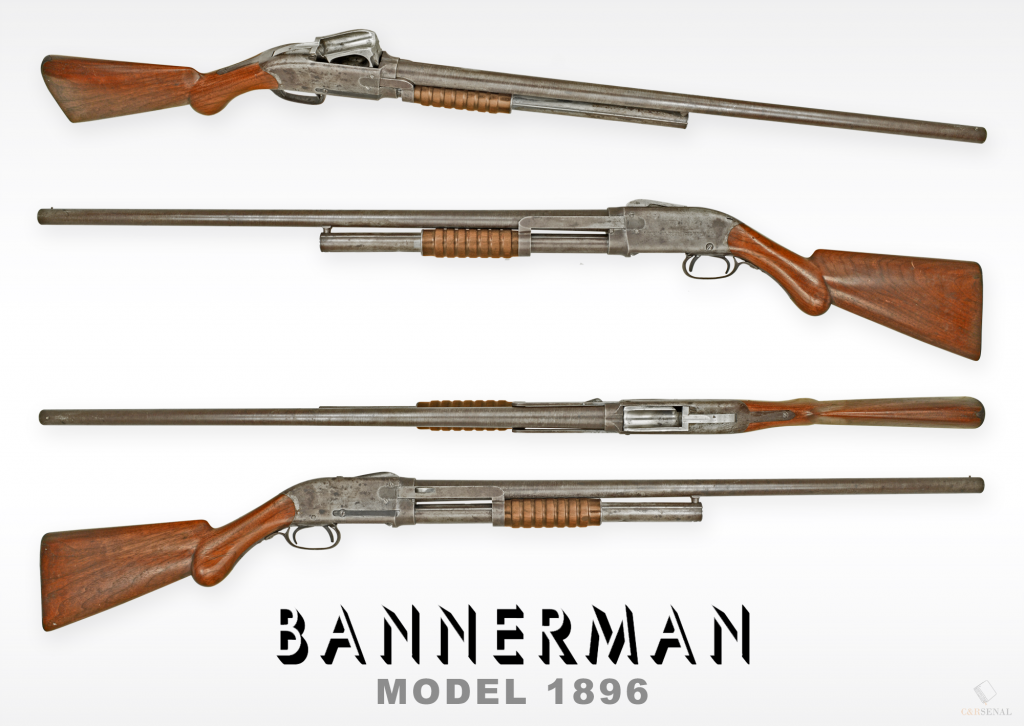


-Same magazine tube, notice the lateral stamped reinforcing ribs on sides! Trapezoid tooth is barely visible on the right side sticking up.
Bannerman vs. Winchester Lawsuit
By the early 1890s, Bannerman was becoming aware of other designers and companies who had come up with similar repeaters, who had been taking some of the market share. One such design was made by Andrew Burgess, who avoided this mess and lawsuits with Bannerman by getting around the Spencer patent completely. He did so by meeting and negotiating with Spencer in 1883 and redesigning, eventually submitting his patent for a sliding wrist shotgun, instead of a pump action(see pic below). In early 1893, the Winchester Repeating Arms Company introduced the John Browning-designed Model 1893 pump shotgun (US #441,390) which had the same operational characteristics. After these experienced quick sales and lots of praise, Bannerman finally had enough in October 1894. He promptly filed an official lawsuit against the Winchester Repeating Arms Company claiming that the slide/pump actions used by both Winchester’s Model 1890, and the new Model 1893 shotgun had infringed on the patents that he owned. Bannerman and his lawyers called for the court to immediately force Winchester to halt production, and to pay $10,000 in damages and royalties for the sale of guns which had infringed on the patent that Bannerman owned. Winchester would temporarily halt production of the Model 1893 during this time, before restarting in mid 1894. Bannerman would spend the next 3 years fighting Winchester in court over these Model 1893 shotguns, and their previous Model 1890 design. Various contemporary newspaper reports from this time suggested that between 100,000 and 200,000 people were directly interested in, and or, affected by this case. A major reason for this was that ordinary owners were liable for paying the damages from the suit due to laws of this time, rather than Winchester if Bannerman had won his suit. This made it quite a large case that was given some publicity and a good bit of interest, as it was mostly unheard of for someone to challenge Winchester in such a way and many owners of their guns were at risk.


In 1894, Winchester would end up stifling the growing fears and rumors by customers by guaranteeing its Model 1893, and promising to refund customers if legal action caused buyers to be responsible, which led them to fight the case even harder in mid 1894. Winchester would dispatch a man by the name of George D. Seymour to Europe to scour the European patent archives for any patents for similar actions that had been filed before the Spencer one was. Mr. Seymour discovered four patents for repeating pump action firearms; three British and one French. The earliest of these was Alexander Bain’s patent of 1854 for a repeating rifle. The next two patents were held by Joseph Curtis and William Krutzsch, both dating from 1866. The final patent was filed by Frenchman M.M. Magot in 1880.
All of these designs, including the Curtis rifle, never progressed beyond the development stage and were nearly forgotten until rediscovered by Seymour. Winchester then used these as their claim that earlier designs invalidated Bannerman’s patent claim. Bannerman then proceeded to claim that these designs were unworkable patents with no surviving prototypes, and should be thrown out as evidence from the trial, and that the Magot gun was not evidence as it came later than his patent.
In response, Winchester decided to build working models of each of the designs to illustrate their defense. During this time they also located a Margot gun prototype. This must have been an immense engineering task for them at this time, as the patent drawings wouldn’t have had any of the needed measurements, materials used, and tolerances needed to produce a working model of each. During 1895-96 Winchester engineers including T.C. Johnson and many others, worked on producing these and ended up building working models of each of the designs to prove their viability. These were then test fired and once they were proven to be working models, they were given to Winchester’s lawyers who took them into court and submitted them as further evidence. The lawyers and Winchester himself then offered a live firing demonstration to be held outside behind the courthouse. The court declined the demonstration, but used these models, and other information from previous cases to make its final decision. (see pic below for these examples made by Winchester)




Judge Hoyt H. Wheeler of the United States District Court for the Southern District of New York ruled in favor of Winchester and threw out Bannerman’s suit on June 27th 1897(See pictures below) At this point Winchester had produced something like 34,000 Model 1893s, and in November 1897 after winning the case, they were free to introduce their new and improved version, the Model 1897. The release of this new model lead them to release a full recall on all Model 1893 guns. This was due to fears of possible blowups/mechanical issues with smokeless loads and lead them to offer a “similar quality new model 1897 for any 1893 turned in.” This is substantiated in historical records and chronicled in George Madis’ “The Winchester Book” page 523.. “Till serials over 31,000, all guns of this model had 2 5/8” inch chambers. Because of impending mechanical problems and the danger of higher pressures developed by smokeless loads, Winchester informed its dealers and customers that they would trade a new model 1897 of equal grade for any 1893 returned. Returned model 1893 guns were destroyed. This resulted in the loss of most model 1893s; they consequently are rarely seen today. There are thought to be less than 3500 left of these models.”


John Moses Browning was at this trial as well, and was quoted as having admitted in the courtroom, that he had copied the Spencer in some ways, just as others had on other designs, but that it was a fundamentally different action. It was also said at the time that the judge may have sided with Winchester due to the fact that many others had infringed on some parts of the patent, such as in the Colt Lightning, and the Burgess shotgun(see my example above). Winchester also had attested that a method of operation such as this was not patentable, but rather its mechanism by which it achieved this was patentable. He attested this as it had been determined to be true in past cases, such as those involving Richard Gatling and his crank operated guns in the past decade. Gatling himself also had tried to sue others for their designs but was denied on this same basis in court trials. (Thanks to designs such as the French Mitrailleuse, Ripley Machine gun, Puckle gun, and the Bailey crank gun, among other more unsuccessful designs).
Christopher M. Spencer was also called into the case as a witness for the prosecution and for his testimony, which covered over 58 pages in the official court record. But despite Spencer also contending that Winchester infringed upon his patents, and that their models did not apply as they were not patented in the USA, the Court ruled against Bannerman. Due to this, Bannerman appealed to the U.S. Supreme Court of Appeals on January 5, 1900, but the verdict was sustained after just 1 short retrial.
Winchester was awarded their defense, and permitted to market any pump action firearms without any further court trials. Even though the Spencer-Bannerman shotgun sales picked up after the trial, it was too late, as Winchester had already been dominating the market. By this time they had sold more than 532,000 Model 1890 rifles and 34,000 Model 1893 shotguns by 1897, and many millions more would be sold in the coming years. Bannerman returned home after this court trial and continued production of his model 1896 till around 1899, when he would introduce his new model. This would be the Model 1899, which has large takedown levers, and a 2nd ejector added to help with extraction which rides along a slot covered by an unusually tall left side plate. This plate rotates to aid in takedown as well. (See below for examples of the 1899/1900 dual extractors, and taller sideplate)


The Model 1899
The Model 1899 would now introduce the largest update on the design yet. This included a 2nd ejector and a taller left side plate, and larger much more pronounced takedown levers on the receiver with a crossbolt, and a magazine tube screw style change as well… although the left side plate being taller was mostly a mystery previously to me, it seems Othias has resolved it for me. This plate and the channel its machined into, along with a thumbnail groove is meant to allow you to remove the top screw, twist the sideplate 90* downwards, and reinstall the top screw. Then you can lock the plate in place with the lower screw and makes the takedown of the gun easier, and it retains the screws out of the users way.
Takedown on these was achieved by turning the receiver takedown lever downward 90*(no need to turn more than this), then unscrewing the mag tube takedown lever until the tube assembly comes off of the barrel, and then turning the barrel counter clockwise till it comes out. The mag tube can now be reattached to the barrel at this point for storage, as the follower and spring are retained in the magazine tube. This model was in production for a VERY VERY short amount of time, and in over 4 years of me searching for them i have only seen 3 pop up for sale, all having the same features and variations of parts and quality of work, and serials within 368 digits of each other. Earliest serial of these ive seen was #18163, latest was Serial #18531.


The Model 1900
The model 1900 seems to have been nothing more than a roll stamping change from the Model 1899. All features are the same and the only thing that seemed to be added was a slight update to the checkering on the takedown screws from all the models ive seen. About ~3450 of these were produced until at least ~#21,954, with production ending around 1904ish. We know this as 1 period ad from 1902, and another from Bannermans 1903 catalogue say that over 20,000 of this design have been produced, and listed them for sale. I have also seen serial #21,954 pop up for sale 2 different times, so there are likely higher serial examples out there as well.
Bannerman’s manual for the Model 1900 stated an interesting training regimen as well…..“For indoor practice, we would suggest loading the gun with empty shells, caps only. Place six pieces of lighted candle three feet from the muzzle of the gun – aim – fire – and if you aim right the light will be blown out – then move the slide handle back full extent, then forward – aim – pull the trigger and repeat the operations until shells are discharged – Go slowly at first until you get the three movements – One, Backward – Two, Forward – Three, pull trigger. These movements can be made with such rapidity that all six shots can easily be fired in three seconds.”
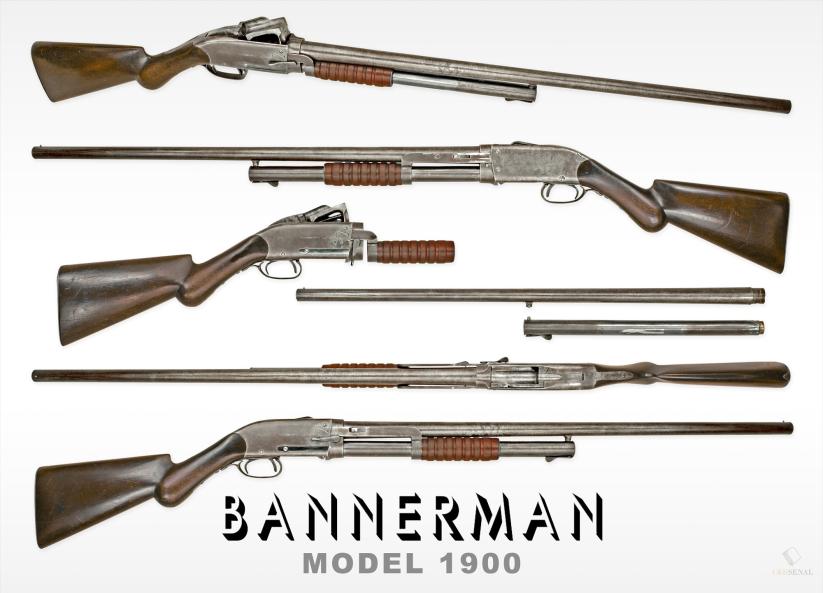
The final years of the Spencer/Bannerman repeating shotgun
Bannerman would go on to sell about 3,000 more of this model from 1900 to around 1904ish, before ending right around serial ~21,960-ish. MANY articles have incorrectly stated that production ended on these shotguns in 1907 but from records that is not true. Bannerman had realized that by mid 1904, the sales just weren’t enough to satisfy him and he decided to switch directions in his business, so he ceased the production of all shotguns, and later announced that his Brooklyn factory was for sale, valued at upwards of $100,000. The reason given for the company’s departure from the shotgun business was that Bannerman wanted to give one hundred percent of their companies effort to the surplus military goods business stating that it was a direction, “which was always more profitable and more to our liking, and on which there is no patent”. No substantiated record exists of what actually ended up of the Bannerman machinery at this auction, or the Spencer tooling and fixtures. It is speculated by many these machines were sold back to Pratt and Whitney, and other makers for their gun businesses. Sadly this is the end of the worlds first successful repeating shotgun design, and worlds first production pump action firearm as well!
End part 2…To be continued. Part 3 HERE
Thank You for reading this, and feel free to comment below with reviews and any questions/info you have! -Seth.
Special Thanks go out to Othias for creating this site and him graciously lending his pictures, and Morphy Auctions Co. & Rock Island Auction Co. for letting me use some of their photos under permission!
Gun guy/gamer/Metalhead/LS car and truck guy.
I have a deep fascination in the mechanical engineering, manufacturing, and history of firearms. Especially rare, unique, and historically significant stuff. I especially like the period between stuff from 1860-1895 ish.
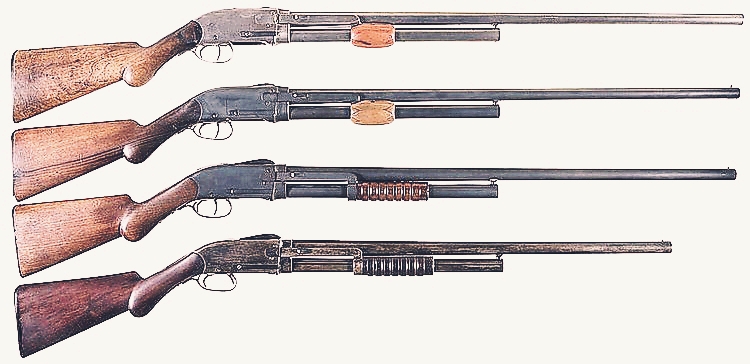
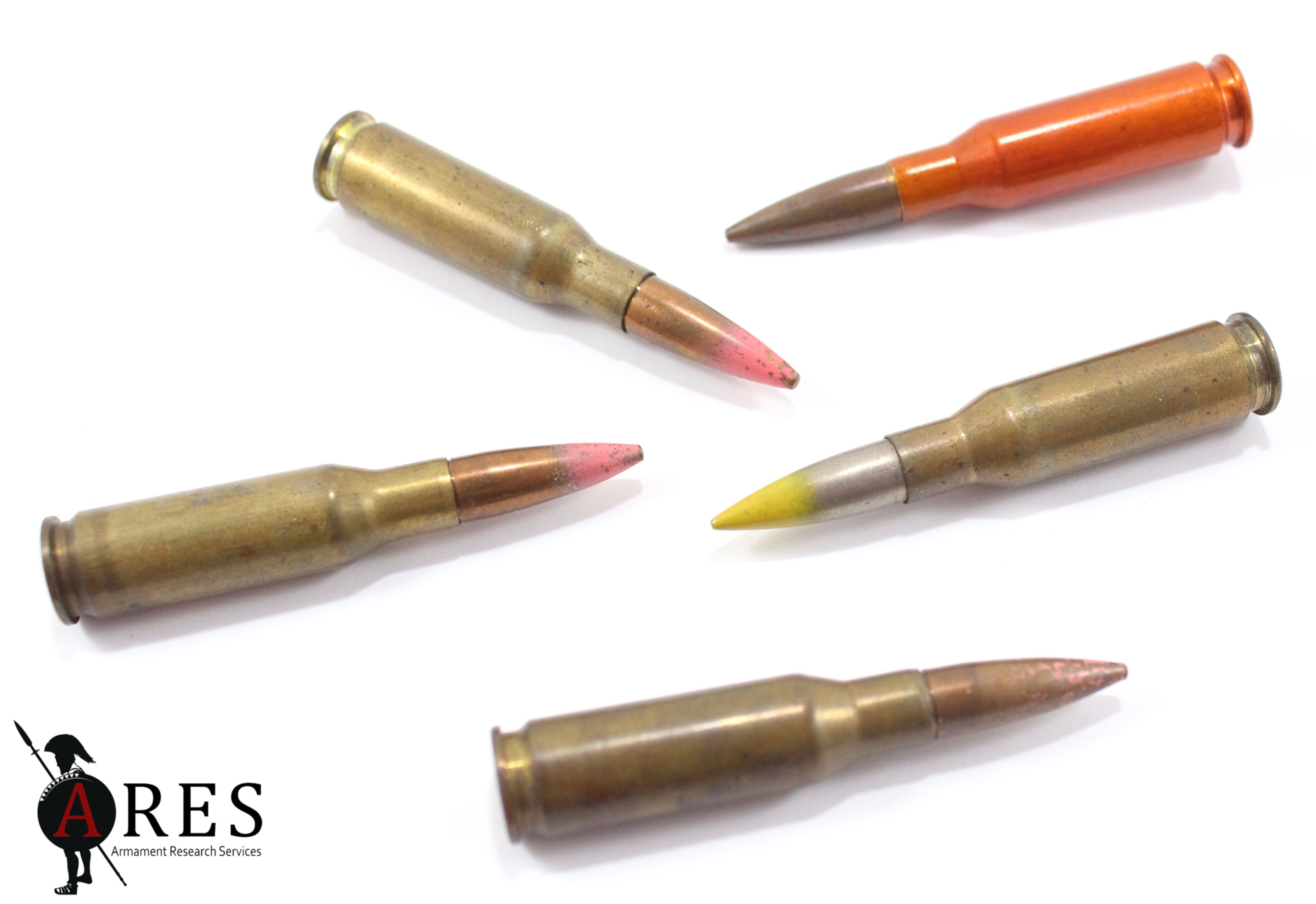
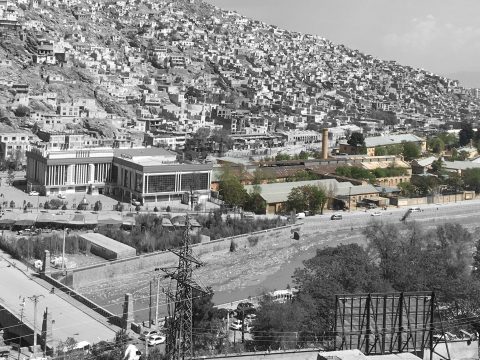
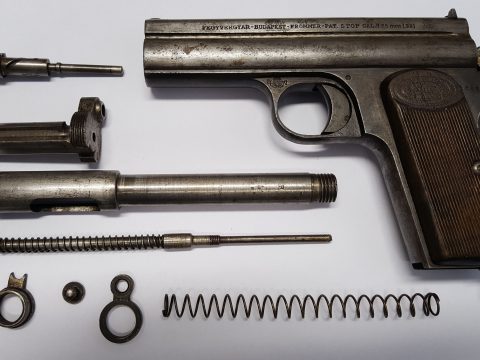
I have a Spencer Repeater Shotgun model 1890. I needed to get the nut that holds on the tube magazine rewelded on. I took the shotgun apart before I brought it to the gunsmith. During the time he had it I lost the follower. Does anyone know where I can get another or where I can find the specs to make one myself?
should be able to use any normal follower for a 12ga shotgun i would think. id start with an 870 one…my Spencer has a 870 mag spring in it lol